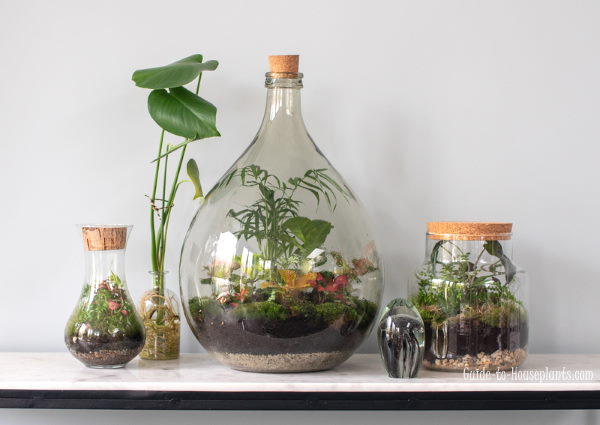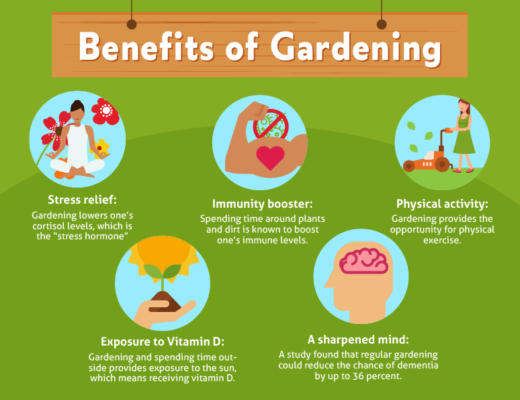A terrarium is a unique type of indoor gardening container that is fully or partially enclosed to allow heat and light to enter while confining moisture. Terrariums can be entirely closed to prevent moisture loss, but often they are left partially open to allow some airflow.
You can make a basic terrarium in less than an hour with very few inexpensive materials. Glass containers, small jars, and even goldfish bowls, make beautiful terrariums and miniature terrarium plants may only cost a couple of dollars each. Terrariums also make wonderful and impressive gifts, even for people who consider themselves plant-challenged.
What You’ll Need
Equipment / Tools
- Large spoon or garden trowel
Materials
- Glass container with or without top
- Gravel, sea glass, or beach stones
- Activated charcoal (found at a nursery or pet supply store)
- Terrarium plants
- Sterile potting mix
- Sheet moss
- Decorative elements (optional)
Instructions
1. Choose the Container
Use almost any clear container or glass jar that has a mouth or lid to make it easy to add plants, such as a large empty pickle jar or Mason jar. (A heavy plastic container is also fine, but most people prefer the look and feel of glass.) A wider bowl allows you to fit more plants, soil, and decorative elements (shells, figurines, or ornaments). Open or Closed Container? Open terrariums are less likely to experience problems with condensation and fungal plant diseases than are closed terrariums.
2. Choose the Plants
Choose terrarium plants that are small enough to fit in your jar, preferably without touching the sides. There are many great terrarium plants, including small potted versions of the following:
- Croton
- Pothos
- Dracaena
- Small ferns
- Lucky bamboo
- Nerve plant
- Prayer plant
- Club moss
- Creeping fig
3. Add Drainage Layers
Your container won’t have drainage holes in the bottom, so you’ll need to create a drainage layer to help keep water away from the plants’ roots.
Put a layer of sheet moss at the bottom of your terrarium to soak up extra water. If you prefer, start with a 2-inch layer of stones in the bottom of the terrarium instead of moss. A tall, narrower terrarium will require a deeper layer of drainage stones than a broad, shallow container.
Next, use a large spoon or trowel to add a 1/4-inch to a 1/2-inch layer of activated charcoal on top of the stones to help drainage and control any odors.
4. Add Moss and Potting Mix
Next, add a layer of moss over the stones and charcoal. This is to keep your next layer, the potting soil, from mixing in with the charcoal and stones, and it also adds visual interest to your terrarium.
With a large spoon or small trowel, add sterile general-purpose potting mix on top of the moss. Add as much potting mix as you can—at least a couple of inches. But make sure to keep the soil level low enough so that the plants will fit without touching the top of the terrarium.
5. Prepare the Plants
Remove the plants from their nursery pots. If they are root bound, tease the roots apart, or perhaps even cut some off. Cutting off some of the roots, called root pruning, will retard your plant’s growth, which is essential when growing plants in the confines of a terrarium.
Design With the Plants
Before planting, decide on the design of your terrarium. Choose where you’ll place tall and short plants and where you’ll create mounds and dips in the soil to create interesting contours.
6. Plant the Terrarium
Shake off excess soil left on plants from nursery pots. Using a large spoon or your fingers, dig a hole for each plant in the potting mix. Place each plant in its hole and gently pat the soil down around it.
7. Decorate the Terrarium
If you’d like, decorate the inside of the terrarium with small figurines, shells, or other whimsical accents spaced among the plants.
8. Water the Terrarium
Water the plants in the terrarium using a spray bottle or watering can with a rose attachment on the spout so they are just damp, but not soaking wet. Use the spray bottle to clean off any dirt clinging to the glass sides of your container, which you can then wipe clean with newspaper or newsprint.
9. Maintain the Terrarium
It’s easy to maintain a terrarium. Do these three steps every couple of weeks:
- Feel the soil to see if it’s dry and needs water. Partially and fully enclosed terrariums retain water considerably longer than most potted houseplants
- Check a closed terrarium for condensation. Take off the top at least once a month to air it out. Leave the top off until the condensation disappears. Do this if you added too much water, as well.
- Pull off yellowing or damaged leaves and prune plants if they’re growing too large.
Tips for Making a Terrarium
Choosing your container and plants is half the fun of making a terrarium. There are many specialized terrarium containers that you can buy, ranging up to those that look like miniature Victorian greenhouses or conservatories that sell for hundreds of dollars. Most garden centers stock miniature plants for terrariums, sometimes in the section of the store containing fairy garden accessories. Here are a few more pointers for choosing plants:
- Larger terrariums can handle houseplants that are somewhat bigger than miniature plants but avoid fast-growing species or those that develop large leaves that will block light from smaller plants.
- When considering terrarium plants, look for plants that thrive in low to medium light. Get a mix of sizes, leaf textures, and leaf colors.
- Select plants that won’t mind the naturally humid environment of a terrarium.
- Avoid cactus and succulents for an enclosed terrarium—those plants work best for fully open containers filled with a potting mix containing plenty of coarse sand.







